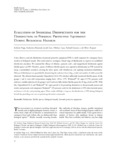Evaluation of Sporicidal Disinfectants for the Disinfection of Personal Protective Equipment During Biological Hazards
Papp, Stefanie
Kimmerl, Katharina
Gatz, Jacob
Laue, Michael
Grunow, Roland
Kaspari, Oliver
A fast, effective, and safe disinfection of personal protective equipment (PPE) is vitally important for emergency forces involved in biological hazards. This study aimed to investigate a broad range of disinfectants to improve the established disinfection procedure. We analyzed the efficacy of chlorine-, peracetic acid–, and oxygen-based disinfectants against Bacillus spores on PPE. Therefore, spores of different Bacillus species were exposed to disinfectants on PPE material by using a standardized procedure covering the dried spores with disinfectants and applying mechanical distribution. Efficacy of disinfectants was quantified by determining the reduction factor (log10 levels) and number of viable spores left afterward. The chlorine-based granulate Hypochlorit CA G (2% chlorine) sufficiently inactivated Bacillus spores of risk groups 1 and 2, even with temperatures ranging from −20 to 35°C. Wofasteril® SC super (1.75% peracetic acid) achieved a reliable reduction of risk groups 1 and 2 and even fully virulent Bacillus spores by ≥5 log10 levels on PPE. With this, Hypochlorit-CA G and Wofasteril® SC super proved to be promising alternatives to the previously proven and widely used peracetic acid compound Wofasteril® (2% peracetic acid) for the disinfection of PPE when bacterial spores are known to be the contaminating agent. These results will help to improve the disinfection of PPE during biological hazards by providing new data on promising alternative compounds.
Dateien zu dieser Publikation

